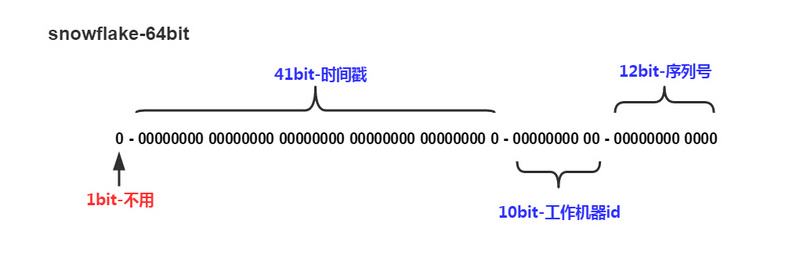分布式系统中我们一般会对一些数据量大的业务进行拆分,如:订单表,用户表。因为数据量巨大一张表无法承载。就会对其进行分库分表。
但一旦涉及到分库分表,就会引申出分布式系统中唯一主键ID的生成问题,永不迁移数据和避免热点的文章中要求需要唯一ID的特性。
分布式id生成算法的有很多种,Twitter的SnowFlake就是其中经典的一种。
概述
SnowFlake算法(简称雪花算法)生成64位的二进制正整数,然后转换成10进制的数。64位二进制数由如下部分组成:
1位,不用。二进制中最高位为1的都是负数,但是我们生成的id一般都使用整数,所以这个最高位固定是041位,用来记录时间戳(毫秒)。- 41位可以表示$2^{41}-1$个数字,
- 如果只用来表示正整数(计算机中正数包含0),可以表示的数值范围是:0 至 $2^{41}-1$,减1是因为可表示的数值范围是从0开始算的,而不是1。
- 也就是说41位可以表示$2^{41}-1$个毫秒的值,转化成单位年则是$(2^{41}-1) / (1000 * 60 * 60 * 24 * 365) = 69$年
10位,用来记录工作机器id。- 可以部署在$2^{10} = 1024$个节点,包括
5位datacenterId和5位workerId 5位(bit)可以表示的最大正整数是$2^{5}-1 = 31$,即可以用0、1、2、3、....31这32个数字,来表示不同的datecenterId或workerId
- 可以部署在$2^{10} = 1024$个节点,包括
12位,序列号,用来记录同毫秒内产生的不同id。12位(bit)可以表示的最大正整数是$2^{12}-1 = 4095$,即可以用0、1、2、3、....4094这4095个数字,来表示同一机器同一时间截(毫秒)内产生的4095个ID序号
优点
1、此方案每秒能够产生409.6万个ID,性能快
2、时间戳在高位,自增序列在低位,整个ID是趋势递增的,按照时间有序递增
3、灵活度高,可以根据业务需求,调整bit位的划分,满足不同的需求缺点
1、依赖机器的时钟,如果服务器时钟回拨,会导致重复ID生成SnowFlake可以保证:
所有生成的id按时间趋势递增
整个分布式系统内不会产生重复id(因为有datacenterId和workerId来做区分)
代码实现(PHP)
/**
* SnowFlake ID Generator
* Based on Twitter Snowflake to generate unique ID across multiple
* datacenters and databases without having duplicates.
*
*
* SnowFlake Layout
*
* 1 sign bit -- 0 is positive, 1 is negative
* 41 bits -- milliseconds since epoch
* 5 bits -- dataCenter ID
* 5 bits -- machine ID
* 12 bits -- sequence number
*
* Total 64 bit integer/string
*/
class SnowFlake
{
/**
* Offset from Unix Epoch
* Unix Epoch : January 1 1970 00:00:00 GMT
* Epoch Offset : January 1 2000 00:00:00 GMT
*/
const EPOCH_OFFSET = 1483200000000;
const SIGN_BITS = 1;
const TIMESTAMP_BITS = 41;
const DATACENTER_BITS = 5;
const MACHINE_ID_BITS = 5;
const SEQUENCE_BITS = 12;
/**
* @var mixed
*/
protected $datacenter_id;
/**
* @var mixed
*/
protected $machine_id;
/**
* @var null|int
*/
protected $lastTimestamp = null;
/**
* @var int
*/
protected $sequence = 1;
protected $signLeftShift = self::TIMESTAMP_BITS + self::DATACENTER_BITS + self::MACHINE_ID_BITS + self::SEQUENCE_BITS;
protected $timestampLeftShift = self::DATACENTER_BITS + self::MACHINE_ID_BITS + self::SEQUENCE_BITS;
protected $dataCenterLeftShift = self::MACHINE_ID_BITS + self::SEQUENCE_BITS;
protected $machineLeftShift = self::SEQUENCE_BITS;
protected $maxSequenceId = -1 ^ (-1 << self::SEQUENCE_BITS);
protected $maxMachineId = -1 ^ (-1 << self::MACHINE_ID_BITS);
protected $maxDataCenterId = -1 ^ (-1 << self::DATACENTER_BITS);
/**
* Constructor to set required paremeters
*
* @param mixed $dataCenter_id Unique ID for datacenter (if multiple locations are used)
* @param mixed $machine_id Unique ID for machine (if multiple machines are used)
* @throws \Exception
*/
public function __construct($dataCenter_id, $machine_id)
{
if ($dataCenter_id > $this->maxDataCenterId) {
throw new \Exception('dataCenter id should between 0 and ' . $this->maxDataCenterId);
}
if ($machine_id > $this->maxMachineId) {
throw new \Exception('machine id should between 0 and ' . $this->maxMachineId);
}
$this->datacenter_id = $dataCenter_id;
$this->machine_id = $machine_id;
}
/**
* Generate an unique ID based on SnowFlake
* @return string
* @throws \Exception
*/
public function generateID()
{
$sign = 0; // default 0
$timestamp = $this->getUnixTimestamp();
if ($timestamp < $this->lastTimestamp) {
throw new \Exception('"Clock moved backwards!');
}
if ($timestamp == $this->lastTimestamp) { //与上次时间戳相等,需要生成序列号
$sequence = ++$this->sequence;
if ($sequence == $this->maxSequenceId) { //如果序列号超限,则需要重新获取时间
$timestamp = $this->getUnixTimestamp();
while ($timestamp <= $this->lastTimestamp) {
$timestamp = $this->getUnixTimestamp();
}
$this->sequence = 0;
$sequence = ++$this->sequence;
}
} else {
$this->sequence = 0;
$sequence = ++$this->sequence;
}
$this->lastTimestamp = $timestamp;
$time = (int)($timestamp - self::EPOCH_OFFSET);
$id = ($sign << $this->signLeftShift) | ($time << $this->timestampLeftShift) | ($this->datacenter_id << $this->dataCenterLeftShift) | ($this->machine_id << $this->machineLeftShift) | $sequence;
return (string)$id;
}
/**
* Get UNIX timestamp in microseconds
*
* @return int Timestamp in microseconds
*/
private function getUnixTimestamp()
{
return floor(microtime(true) * 1000);
}
}